Giant squid that can sink ships is thought to be only a legend and a 150-year-old mystery that has just been solved
The giant squid, or Architeuthis, is one of the ocean’s most mysterious creatures.
Living at depths of 396 to 914 meters below the sea, the giant squid inhabits the deepest, darkest places on Earth. To this day, humans still don’t fully understand how these giant creatures live, how they mate, how they migrate, or how they make sounds. In short, they remain a mystery.
Some genetic studies have confirmed that giant squids have existed for 730,000 years. They have also appeared in human legends for hundreds of years, such as the legendary sea monster Kraken in Norse mythology, or the giant octopuses in the novel “Twenty Thousand Leagues Under the Sea” by the great writer Jules Verne.

Illustration of the giant octopus in the novel “Twenty Thousand Leagues Under the Sea”
Notably, the “Natural History of Norway” published in 1755 described the giant squid as being the size of “several small islands”, which caused giant whirlpools that sucked in human boats every time it dived into the sea.
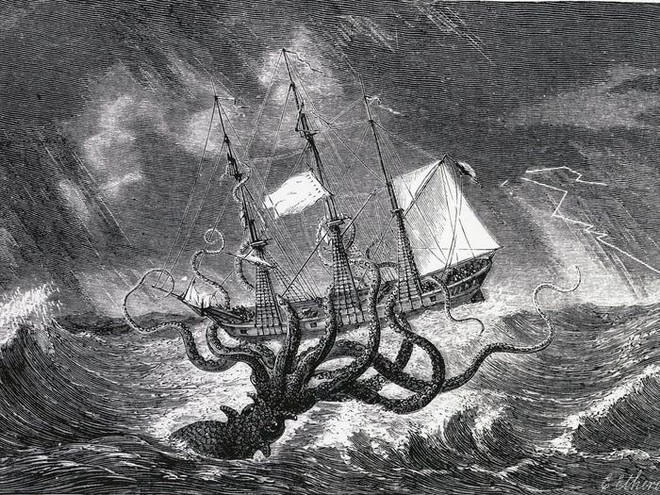
Kraken monster in Norse legend
Until about 150 years ago, most of us didn’t think giant squids were real. They were considered a mythical sea monster, spun by sailors’ tales. However, evidence of their existence has become increasingly clear thanks to another animal – the sperm whale. Scars on the bodies or beaks of squids found in the stomachs of sperm whales have shown that a deadly battle took place between these two giant creatures in the deep sea.
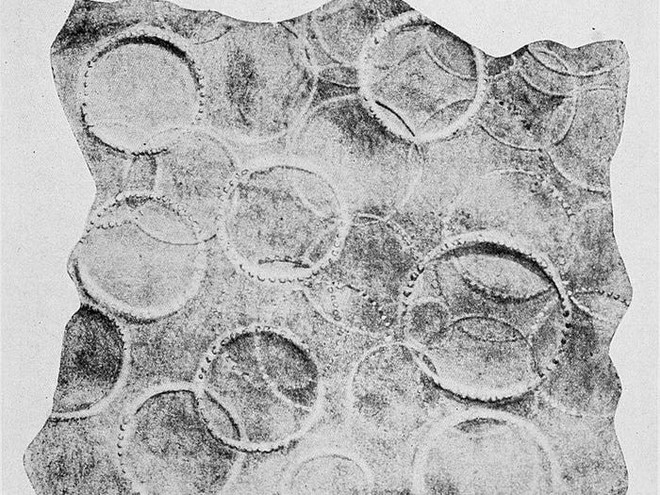
Scars on sperm whale’s body believed to be caused by giant squid
In 1857, Japetus Stee nstrup, a zoologist from the University of Copenhagen, Denmark, first proved to the world’s scientific community the existence of giant squid. The announcement was made after the professor studied a part of a squid’s beak that had washed up on the shores of Denmark. He named them Architeuthis Dux, Latin for “king squid”.
Despite Streenstrup’s initial success, no further significant studies of giant squid were published for more than a century, due to their rarity.
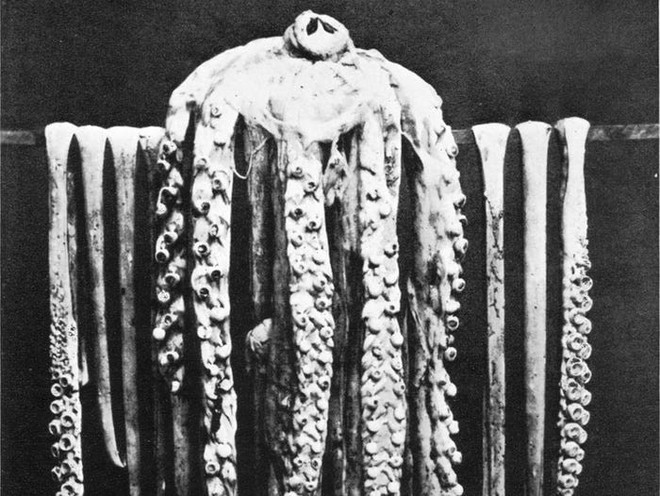
A giant squid’s 5m long tentacle was found by fishermen in Conception Bay, Canada in 1873.
In 1997, the National Geographic Society attached cameras to sperm whales in the hopes of witnessing their encounter with giant squid, but was unsuccessful.
In 2003, Steve O’Shea, one of the world’s most renowned giant squid researchers, led a team in an attempt to film giant squid as they migrated into New Zealand waters. His plan was to crush the squid’s genitals and mix them into the water so the giant squid could mate right on camera. However, the experiment ultimately failed.
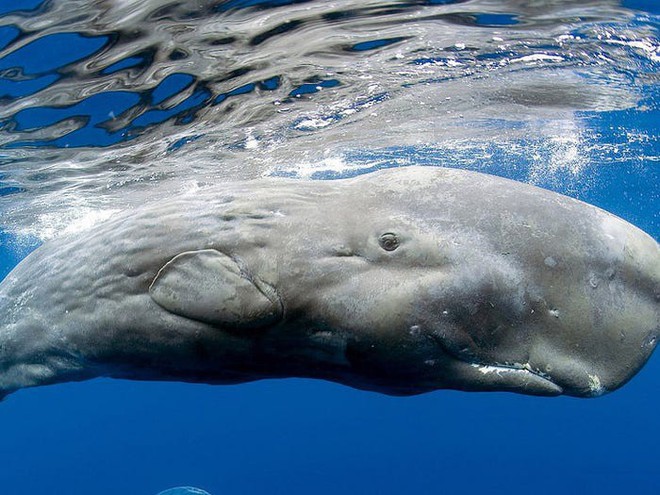
Sperm whales regularly have encounters with giant squid.
On September 30, 2004, marine biologists Tsunemi Kubodera and Kyoichi Mori took the first photograph of a giant squid living off the coast of Japan’s Chichijima Island, after discovering many scars on the bodies of sperm whales living in these waters.
They lowered a device with a camera and bait to a depth of 914 meters. A giant squid measuring about 7 meters in size used its tentacles to wrap around the bait. After 4 hours of struggling to free its tentacles, the squid died.
Mr. Tsunemi said the incident changed the image of giant squid, from a gentle creature to a fearsome predator of the deep sea.
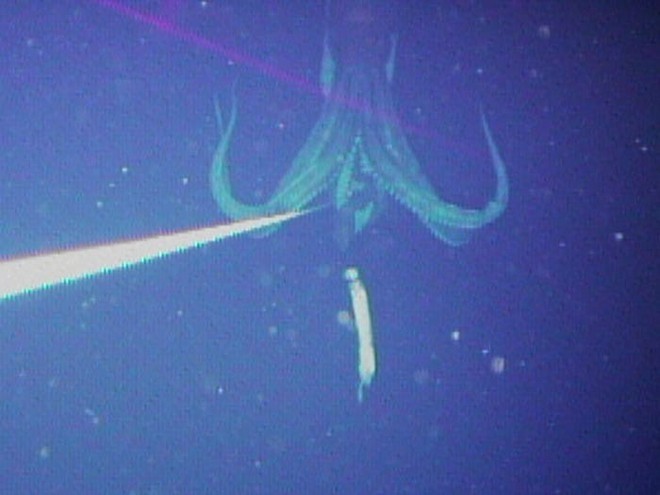
First photo of giant squid at depth of 600m
Remarkably, in 2006, Tsunemi’s team went on to release the first video of a live giant squid. It was relatively small, weighing only about 50 kilograms and measuring 3.3 meters long, but it was the first live image of the creature. “No one had ever seen a live giant squid except fishermen,” he told Reuters.

A giant squid being pulled up by a Japanese research team in 2006.
In 2012, for the first time in history, scientists filmed a giant squid in its natural habitat. The footage was captured using a special camera designed by biologist Edith Widder that emits blue light.
According to this biologist, the number of giant squids in the oceans could be up to millions to be able to feed so many sperm whales.
However, in order to avoid human pursuit, this squid rarely appears. Understanding this, she designed a camera without thrusters or motors, and without emitting red light because it is completely invisible to underwater animals, which are adapted to seeing only blue light.
The largest giant squid ever recorded was 13 metres long, but scientists believe they could have reached up to 20 metres. They also have the world’s largest eyes, measuring up to 30 centimetres in diameter, about the size of a basketball.
Giant squid have eight small tentacles and two long tentacles to catch prey. But their tentacles don’t have any muscles to restrain their prey. So if faced with a sperm whale, they can only run away.
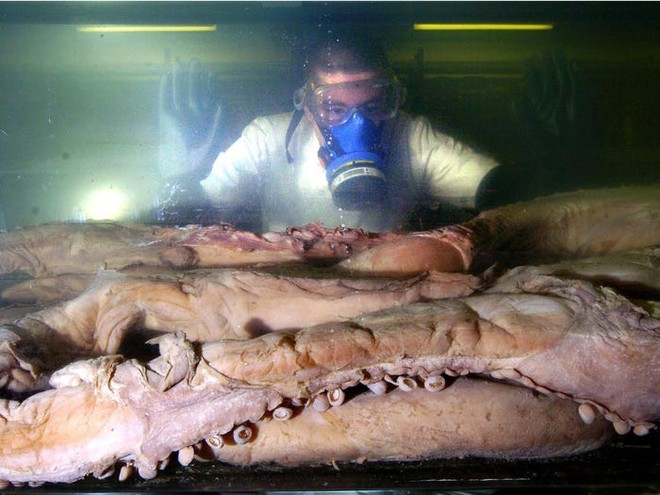
A giant squid specimen on display at the Darwin Centre museum (UK)
Despite being spotted on camera many times, scientists say the giant squid remains a mystery. As the ocean becomes warmer and more acidic, the giant squid could become extinct before we can study them properly.
News
Top 10 Most Beautiful Indian Actress in 2024 | Only Top10
Top 10 Most Beautiful Indian Actress in 2024 | Only Top10 Bollywood Actress: The Bollywood film industry holds a prominent position in Indian cinema, known for its grandeur and captivating storytelling. With their remarkable performances and exceptional acting prowess, numerous…
Who Is The Most Popular Bollywood Actress 2024?
Who Is The Most Popular Bollywood Actress 2024? Bollywood has always been home to some of the most talented and iconic actresses who have defined and redefined Indian cinema over the years. As we step into 2024, the competition is…
Reality of Malaika Arora and Arjun Kapoor’s div0®ce / Has Malaika Arora found a new boyfriend?
Reality of Malaika Arora and Arjun Kapoor’s div0®ce / Has Malaika Arora found a new boyfriend? Malaika Arora teases her relationship status for first time after Arjun Kapoor confirmed he is single Malaika Arora and Arjun Kapoor started dating in…
Alia being SHADY towards Sara? | Genelia takes a dig at Sonam Kapoor?
Alia being SHADY towards Sara? | Genelia takes a dig at Sonam Kapoor? Genelia Deshmukh’s Comment From A Clip Goes Viral Where Sonam Kapoor Was Called ‘Jealous’ Of Her Genelia Deshmukh dropped a comment on a reel that called out…
Shah Rukh Khan is the ULTIMATE role model: Life Lessons for Kids from the Bollywood Superstar
Shah Rukh Khan is the ULTIMATE role model: Life Lessons for Kids from the Bollywood Superstar Shah Rukh Khan, often called the King of Bollywood, is not only known for his exceptional acting but also for the life lessons he…
2nd time pregnant Alia Bhatt hide her baby bump at Raj Kapoor 100 anniversary celebration
2nd time pregnant Alia Bhatt hide her baby bump at Raj Kapoor 100 anniversary celebration Alia Bhatt, Sonam Kapoor THESE top B-town celebs moms whose maternity style is on point Here a list of Bollywood actress who has up their…
End of content
No more pages to load











